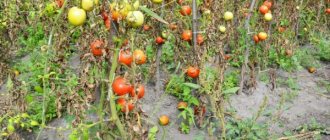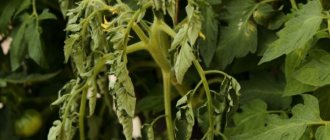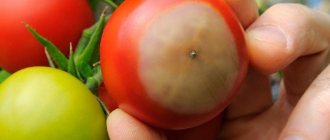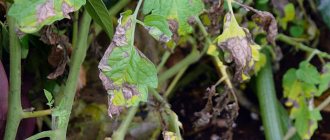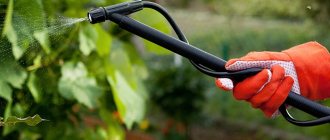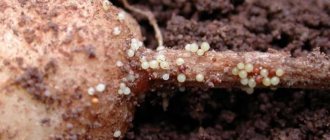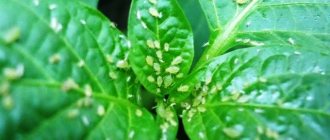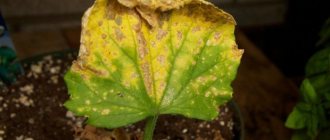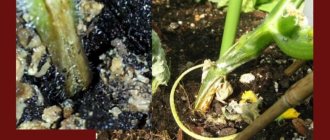What kind of disease is this
Mosaic is a viral disease that affects tissue at the cellular level . Chloroplasts are damaged and chlorophyll is destroyed. At the same time, the processes of photosynthesis and the formation of nutrients are inhibited. Areas of tissue die and the plant dies.
The pathogen attacks many plants : cucumbers, tomatoes, cabbage, peppers, tobacco and others.
For reference . The virus remains viable in soil for decades.
How does it show up on cucumbers?
Mosaicism can be diagnosed by light (white or yellow) spots on the leaves . Over time, the affected leaf plates become deformed and dry out. Some types of mosaics lead to the appearance of dark green stains on the tops.
The virus also affects the fruits : cucumbers become distorted, become stained and become bitter.
Why is it dangerous?
Mosaic viruses are not dangerous to humans . Damage consists of partial or complete loss of yield due to the pathogen.
The spread and persistence of the infection threatens the well-being of healthy plants and future plantings.
Cucumber varieties resistant to mosaic
Currently, breeding companies are trying to create cucumber varieties that are resistant to various diseases. Currently, there are a number of cucumber varieties and hybrids that are resistant to the mosaic virus.
On seed packets, manufacturers usually indicate information about the resistance of a particular cucumber variety to certain diseases, including mosaic, powdery mildew, downy mildew or peronospora, cladosporiosis, anthracnose, root rot, olive spot and others.
The most mosaic-resistant varieties and hybrids of cucumbers:
- Bingo F1,
- Karin F1,
- Camilla F1,
- Daniyar F1,
- Guys from the F1 garden,
- Zyatek F1,
- Lady fingers F1,
- Arbat F1,
- Balcony miracle F1,
- Carolina F1,
- Princess F1,
- Maresa F1,
- Anticipator F1,
- Baikonur F1,
- Viorel F1,
- F1 Director,
- Reckless F1,
- Swallow F1,
- Gunnar F1,
- Pasalimo F1.
Mosaic comes in different types; some manufacturers indicate the resistance of cucumber varieties specifically to ordinary mosaic.
Varieties of cucumbers resistant to common mosaic:
- Ant F1,
- Herman F1,
- Herald F1,
- Espagnolette F1,
- Meringue F1,
- Gosha F1,
- Amor F1,
- Ajax F1,
- Bjorn F1,
- Millionaire F1.
Mosaic is one of the most serious diseases that can affect cucumbers.
. It can destroy almost the entire crop in a short time. To prevent the occurrence of this disease, you need to take preventive measures and follow the rules of care. Only then can you count on harvesting a good harvest from the cucumber beds.
Types of mosaics
There are several types of mosaics . The most common are tobacco, common, green speckled and white.
Attention! Several types of mosaic disease can develop on one plant at once.
Tobacco
Tobacco, tomatoes, and peppers are more susceptible to tobacco mosaic. Cucumbers are rarely infected.
The causative agent of this disease, tobacco mosaic virus (TMV) , was one of the first to be discovered.
Symptoms of the disease:
- beige stains forming a mosaic pattern on the leaves;
- the green parts of the leaf blade are swollen, tuberous;
- withering and dying of foliage with the development of the disease;
- underdeveloped, ugly appearance of the fruit.
Ordinary
The appearance of ordinary mosaic is caused by the Cucumber mosaic virus (CMV) .
In addition to cucumbers, this variety attacks tomatoes, beans, and cabbage. Signs of CMV on cucumbers :
- dark green and light green areas randomly located on the leaves;
- edges of the leaf blade turned down;
- cracks at the base of the stem;
- shortened internodes;
- fallen flowers;
- speckled, wrinkled, twisted fruits.
The common mosaic virus dies at a temperature of 60-70ºC for 10 minutes. It is not transmitted through cucumber seeds.
Green speckled
Another name for the disease is English cucumber mosaic.
The pathogen is a highly specialized cucumber green mottled mosaic virus (CGMV) , or Cucumber green mottle mosaic virus (CGMMV).
It attacks only plants of the pumpkin family. Most often it develops in closed ground . Both seedlings and adult plants are susceptible to infection.
Symptoms appear after a sharp rise in temperature to 30ºC:
- leaves become wrinkled;
- the veins acquire a light shade;
- plants quickly wither;
- cucumbers are covered with spots in the form of a mosaic.
The pathogen CGMMV is resistant to heating up to 90ºС , freezing, and drying.
White
White mosaic often accompanies green mottle and is caused by the Cucumis virus 2A (CV2A) virus.
A favorable environment for the development of the disease is the combination of warm air in greenhouses and dense plantings.
Signs of white mosaic:
- small yellow spots near the veins;
- spots in the form of rings or stars of a greenish-white color;
- white leaf color due to fusion of spots;
- slow growth.
The virus persists in soil and seeds.
IODINE AND GREEN - SAVING CUCUMBERS FROM ALL DISEASES AND AN EXCELLENT FEEDING!
Varieties of mosaics
Tobacco - extremely rarely affects cucumber crops. To a greater extent, it is recorded by summer residents who grow sweet peppers. A characteristic marble pattern is formed on the leaf plate. After a few days, the tobacco cucumber mosaic begins to fall off the leaves. Other types of viral disease.
| Variety | Signs | Notes |
| Ordinary | Found in greenhouse conditions. One has only to look at the photos posted in reference books to see the main symptoms. Many small round white spots appear on the leaf blade | After 1-2 weeks, the edges of the leaves, which suffer from ordinary mosaic, curl up. There is no quick way to treat them. Green elements are removed |
| Green | The first signs are noticeable immediately after transplanting the fruit into the ground. The leaves gradually become swollen. Many light yellow spots form on their surface. | The affected bush stops growing. Leaves fall |
| White | At the initial stage, there are no visible signs on the leaves of planted cucumbers. Only upon detailed examination can you see dots with a pale yellow-white tint | If no response measures are taken, the stains will become larger. Subsequently, the white cucumber mosaic changes the shape of the leaf plate |
In severe cases, several viral diseases occur in the area. For example, green and white mosaic symptoms are noticeable on the leaves. The latter is referred to as the “CV2A virus.” More often it is recorded in greenhouses where seedlings are planted too densely. A gardener should pay attention to the following signs:
- near the veins, barely blurred spots of white-yellow color are visible;
- after 4-5 days the spots merge;
- their color changes to white-green;
- the leaf becomes pale yellow or white.
After a week, the affected bush stops developing. There is no cure, so all that remains is to remove it and burn it.
On a note!
As soon as the first signs of the disease appear, the seedlings need to be treated. Not only the bush suffers, but also the fruits. They change shape and then acquire a bitter taste.
Causes
The mosaic virus may not appear for a long time. Favorable conditions are required for activation.
Conditions for development
The pathogen begins to develop on weakened plants:
- Sudden changes in temperature - decrease to 13ºС, increase to 30-32ºС - negatively affect the growth and health of plants.
- Lack of moisture deprives the superficial root system of cucumbers of nutrients. Excessive watering without loosening leads to the formation of crusts on the soil surface and a lack of oxygen at the roots.
- Lack of minerals (potassium, magnesium, phosphorus) reduces immunity to infectious diseases.
- Dry air in greenhouses causes plants to actively evaporate moisture, which leads to an imbalance of salts in tissues.
All of the above leads to stress and a decrease in the resistance of the vegetable.
It will be interesting:
How to grow cucumbers on the balcony and get a harvest
How to grow a cucumber for seeds and collect seed material
How cucumber juice affects the body: benefits and harms, application
Sources of infection
Infection of vegetables occurs in several ways:
- use of contaminated seeds;
- contact with contaminated plants or plant debris;
- spread by pests - virus carriers (aphids, thrips, mites);
- from weeds, in the roots of which the infection persists;
- planting in contaminated soil.
Cucumber mosaic - what is it?
The disease is caused by a harmful and widespread phytovirus (necrotic strain), which can infect about seven hundred different plant species. It belongs to natural focal pathogens and is so small in size that it penetrates through the smallest bacterial filters.
Important! The danger is that almost all garden crops are infected with the cucumber mosaic virus, and infection of one plant can lead to the death of neighboring crops. It is impossible to cure a diseased plant; you can only localize the source of infection.
Once in clean tissue, the virus quickly spreads using special mechanisms - it causes the destruction of chloroplasts, partially destroys chlorophyll, leads to the breakdown of plastids, and significantly reduces the amount of carbohydrates. The combination of these factors affects the condition of the tissues - they die and, as a result, the plant dies.
Mosaic diseases are observed in almost all territories of the CIS in open ground and in greenhouses, so we can talk about the resistance of the virus to environmental factors.
How the infection spreads
The virus is spread in nature by aphids (about 70 species), which transfer it from wild plants to cultivated plants. For example, melon, common, potato, and greenhouse aphids. The infected plant begins to produce a special substance with an odor that attracts the pest, but after taking a sample, the insect realizes that it is infected and leaves it, taking the virus with it.
It does not stay long on the “sick” person; it finds another source of power. That is why there are many times more aphids on a healthy plant than on an infected one. Viruses like cucumber viruses do not live in the body of the carrier and are there until the first “clean” plant.
Other routes of infection:
- infected seed material;
- contact with a source of infection (plant debris, diseased plants, contaminated soil);
- weeds, in the roots of which viruses survive even in severe frosts;
- untreated instrument.
Under what conditions does it develop?
For the mosaic virus to develop, certain conditions are necessary and, knowing this, you can deprive it of an environment favorable to it. A comfortable environment for it is the tissues of a weakened plant.
Factors weakening cucumber culture:
- air temperature difference – below 13 °C and above 32 °C;
- lack of moisture - roots are deprived of essential nutrients;
- when there is excess moisture and the loosening regime is violated, a crust forms on the ground, which interferes with the supply of oxygen to the roots;
- lack of minerals - decreased immunity;
- imbalance of salts in tissues with insufficient humidity in the greenhouse.
Treatment of mosaic on cucumbers
It is impossible to cure a plant from mosaic , you can only localize the development of the disease.
At the first signs of infection, remove the affected leaves and shoots and burn them outside the site. The instrument is disinfected with boiling water, alcohol or a solution of potassium permanganate.
Important! There are no specific antiviral drugs for plants; viruses are not sensitive to pesticides.
If the damage is minor (up to 20% of the foliage), you can treat the area with a weak solution of potassium permanganate. At the initial stage, the development of the disease is stopped by spraying with a solution of whey diluted with water in a ratio of 1:10, with the addition of 15 drops of pharmaceutical iodine per 10 liters of the mixture.
To reduce the risk of infection spreading to healthy plants, you can use insecticides that kill vector pests.
Comfortable conditions for plants should be restored : optimal humidity, watering regime. It is useful to fertilize with microfertilizers.
In advanced cases with extensive infection, the plants are destroyed : they are burned in the area where they grew. This way the soil is also disinfected by fire.
Reasons for mosaic
The virus can be present in the area for a long time, but it awakens only under certain factors.
The most significant factors for the development of the disease are improper ground and air temperatures and humidity indicators.
- When the thermometer drops below +15 °C at night , cucumbers stop growing and completely use up the supply of nutrients accumulated during the day to maintain life processes. If the temperature drops to +10 degrees , the plant dies.
- Heat above +30 °C is not conducive to crop development due to inhibition of the formation of useful substances. Cucumber lacks the necessary energy, which makes it vulnerable to many diseases. The optimal temperature is considered to be air and soil heated to +25 °C .
- Low soil moisture does not allow the nutrients that reach the root system to dissolve. However, waterlogging of the soil is not desirable, as is its dryness. A large amount of liquid in the ground displaces air from it, resulting in oxygen starvation. The best indicator of soil moisture is a concentration of no more than 85% .
- Low air humidity leads to strong evaporation of moisture from cucumber leaves, which leads to slow growth of greens. An increased concentration causes the appearance of dew, which is a conductor of many infections.
- When applying mineral fertilizers to the stems of cucumbers, you need to take into account that an excess of nitrogen, as well as its deficiency , can reduce the immunity of the crop.
Viruses can be carried by insect pests, such as melon aphids or spider mites.
The reasons for the spread may be the following factors:
- last year's plant remains;
- unsteamed greenhouse soil;
- weeds;
- infected seeds;
- rains with disease spores.
Crops infected nearby can infect nearby plants.
Preventive measures
The main fight against mosaic lies in prevention. The following measures will help protect the area from the disease :
- Crop rotation prevents the accumulation of viruses in the soil. Cucumbers should be returned to their original place no earlier than after two years.
- Seed disinfection. Before planting, you need to soak them in a 1% solution of potassium permanganate for 50 minutes.
- Annual replacement of the top layer of soil (10-12 cm) in greenhouses.
- Weeding and removal of all plant debris from the site. The roots of perennial weeds retain viruses during the winter.
- Timely destruction of pests (aphids, mites, thrips and others).
- Do not thicken the plantings. For 1 sq. It is recommended to plant no more than four plants.
- Disinfection of garden tools after picking seedlings, pinching, etc.
- Regular abundant watering and fertilizing.
Description of the disease
Mosaic is an extremely harmful viral disease that affects not only cucumbers, but also crops such as cabbage, pumpkin, garlic, tomatoes, peppers, beans and many others. The causative agent of the scourge is the Cucumber mosaic cucumovirus (CMV), which, due to its microscopic size, can slip through the finest bacterial filters, for which it is also called “filtering”.
The main danger and peculiarity of the mosaic is the presence of a host carrier - aphids, which is why the disease has become widespread in open ground conditions. The pathogen is localized mainly in plant cells, but its shelf life in plant debris and soil can reach several decades.
Besides insects, other sources of the virus also include:
- infected seed material;
- plant remains of the previous crop generation;
- weeds growing near the area with crops;
- contaminated garden tools.
Before people became aware of the nature and measures to combat the mosaic virus, it caused enormous damage to all agricultural crops, in particular tobacco.
Did you know? The beneficial properties of cucumber were known even before our era - the ancient Greek physician Hippocrates more than once mentioned its ability to treat most diseases. A little later, Christopher Columbus, during his travels, forced sailors to eat both fresh and pickled cucumbers in order to prevent scurvy.
Today, several types of the disease are known:
- tobacco mosaic;
- green speckled;
- white;
- ordinary.
Of these, the most commonly found on cucumbers are green speckled mosaic and ordinary. The disease destroys plants at the cellular level, leading to tissue death and disruption of all vital processes. Infection most often occurs through mechanical damage to the fruit, however, even healthy cucumbers in contact with diseased specimens will not escape this fate. Having penetrated the plant through damaged areas, the virus strives to enter through the vessels, first into the root and then into the stem of the cucumber, destroying tissue cells and chloroplasts along the way.
The harmfulness of the disease is extremely high - in just a few weeks the virus can destroy up to 70% of the crop. In order to protect their crops from irreparable losses, each gardener should familiarize themselves in advance with the signs of the disease, the conditions for its development and preventive measures that will subsequently prevent the virus from appearing either on the site itself or near it.
Useful tips
A few tips and recommendations from experienced gardeners will help you in the fight against mosaic disease of cucumbers:
- plant disease-resistant varieties and hybrids, for example, Thumb Boy f1, Masha f1, Pasadena f1, City Cucumber f1;
- To maintain an optimal microclimate in the greenhouse, place several buckets of water. During the daytime, water evaporation will maintain the required humidity; when the temperature drops at night, the liquid will release the accumulated heat;
- To prevent diseases, use the water-based drug “Farmayod”. To prepare the working solution, take 1 teaspoon of the product per 1 liter of water. Treat plants, greenhouse structures, garden tools.
The main symptoms of mosaic appearance
The first sign of the appearance of a mosaic on cucumber vines is a change in the size of the leaf plates - they wrinkle, dry out and begin to curl
. Also, light and dark spots appear on the foliage, arranged in the form of a mosaic - which is why the disease got its name.
Cucumber mosaic virus - treatment methods
There are other signs of cucumber mosaic disease:
- cucumber lashes become deformed and cracks form in them;
- practically no flowers form on cucumber shoots, and if they do form, they are much smaller;
- ripening fruits quickly dry out and turn yellow;
- if the disease becomes chronic, then the vegetative mass of cucumber bushes becomes colorless, and the plant itself withers.
Mosaic has a negative effect on the entire plant - it slows down growth and development, and productivity is reduced to almost a minimum
.
On a note!
Cucumber fruits also change dramatically under the influence of this disease - they remain small, spots appear on the skin, bitterness appears in the taste, and their appearance also deteriorates.
Mosaic can appear at different stages of cucumber development, but most often it affects seedlings. But in cucumber varieties resistant to the disease, the incubation period of the disease can be about 28-30 days, and in varieties with low resistance it can be no more than 1.5 weeks. Therefore, if the mosaic is detected in a timely manner, the rapid spread of infection can be avoided and it can be destroyed.
Cucumber mosaic - causes of the disease and measures to combat it
Mosaic is a very common viral disease that affects many plants. It can spread to them with the help of infected seeds and plant juice during picking. Also, a vegetable can become infected with a disease if a carrier is near it.
Any virus will damage a sick or damaged plant much more than a healthy one. They penetrate through damaged tissue and then penetrate deep into the roots.
Recently, a disease of cucumbers that grow in a greenhouse - “mosaic” - has been very often observed. Treatment is most often carried out by replanting or treating plants with fungicides, but most often such actions do not bring any results.
Aphids are another dangerous plant vector. It can easily attack plants and even flowers (for example, gladioli, dahlias, phlox).
